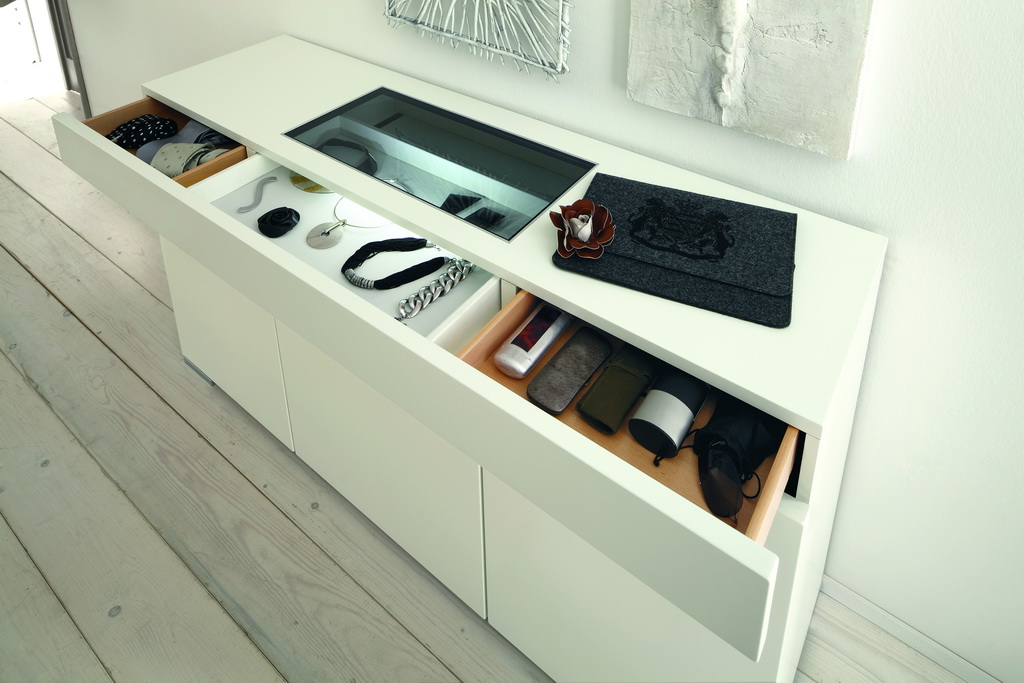When tidying up invites us to live…
Just for the record, it should be noted that they still exist: cupboards and cabinets, high and low sideboards, bookcases, closed chests and other furniture with drawers. In the digital age – in which books still enjoy wide popularity, contrary to all predictions – both are needed: open shelves and boxes for presenting collectibles as well as storage space that can be shielded from view.
Finding the common denominator is easy. Because regardless of whether people are on the go in a more virtual world or bound to a more material one – for both types, a tidy appearance is more in demand than ever.

A minimalist furnishing style, like cool staging in organised chaos, is based on a concept of deliberately proportioned display. For anyone who values a structured living environment, tidying up is an integral part of interior design. And today there really are organiser items that suit every organisational type.
With a cabinet used as a room divider, for example, the storage area is made into the centre of the home and brings a unique loft atmosphere into even the most modern open-plan flat. As an open compartment behind the sofa, a shelf block offering an unobstructed view from all sides, or a compact sideboard (sometimes even with a lighted showcase drawer), organising furniture not only produces storage space, but also creates an island that positively cries out for decoration. Lights, flowers, design elements, baskets of fruit, the hat collection or the lawn gnome that has been converted into a candleholder really come into their own here. Such storage furniture, freely positioned as stand-alone items throughout the room, is an increasingly common alternative to the kitchen block.

Interlübke, for example, is offering cube gap, a modern interpretation of the programme first launched in 2002 with designs by Werner Aisslinger. The collection includes a sideboard that not only opens in every direction, but also looks particularly elegant, as it is made of a new material variant in a fashionable, shimmering black, called “black concrete”. This surface, reminiscent of concrete, is produced in a manual process in which several layers are enriched with natural mineral pigments, ground down one by one and finally sealed with a razor-thin layer of acrylic resin that allows the vibrant structures and colour shades underneath to shine through. And mell, the new collection with especially delicate details (design: jehs&laub), encompasses all kinds of furniture, from the bookshelf to the bed and from the built-in wardrobe to the bureau, and seems more like a family of stand-alone furniture than a coordinated programme. In fact, mell, too, includes low boards that can be used as room dividers.

Inner compartments made with an eye for detail – like the compartments that were on show at interzum – cater particularly well to the passion for both order and presentation. For consumers, the interior design of chests and drawers is growing more and more important, and not just in the kitchen or the washbasin drawers – whose interiors today resemble a still life of lipsticks organised by colour, scarves, small jars, cups and hair accessories – but also increasingly in the living room and bedroom. Belts, scarves and socks want to be organised; rarities, model cars and flea market finds want to be put on display. The good old vitrine and the letter case from the ’70s and ’80s are turned into LED-illuminated shelves or drawers with an overlaid glass base, perfectly integrated into representative shelves, chests and sideboards.

In our flats, we surround ourselves with small display showcases and cabinets. For some time now, individually combinable shelves made from boxes that can be stacked or nested have been on-trend. They represent a middle ground between classical shelving or cabinet systems and the open shelves and media furniture which have emerged in countless variations and which, with a reduced depth and minimalistic design, seem to serve only to prevent the smartphone from looking quite so lonesome next to a few selected accessories. The boxes that follow in the Bauhaus tradition, on the other hand, allow for the presentation of collector’s items as well as of more substantial “life companions”, such as books, cacti, the vinyl record collection, kitchen utensils or parlour games.

What is striking is how easily this type of furniture can be adapted to individual requirements, as with the mell or cubit, whose elements are not infrequently made to be combined freely with one another in the most varied materials, colours, heights and depths. This creates entire shelf landscapes, sometimes cliff-like, that climb up the walls with projections and recesses or spread out freely across the wall, as in a salon hang. They keep pace with every change in requirement, whether as individual pieces of furniture or in groups.

The most recent collection by Cassina shows that this trend has established itself and is by now a part of the canon of conventional furniture: the Italian manufacturer is introducing W54 Dada (design: Kazuhide Takahama), a modular system made of solid wood that allows for flexible combinations of shelves, arranged freely across the room or on the wall, or of side furniture for lounge suites. Whether they are massive or delicate, elegant or unconventional, alone or in a steady relationship: playing with shelves is on trend like never before.
